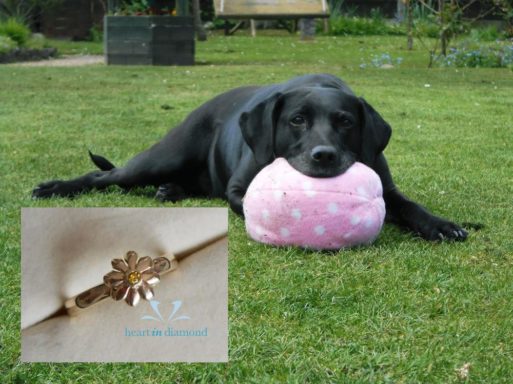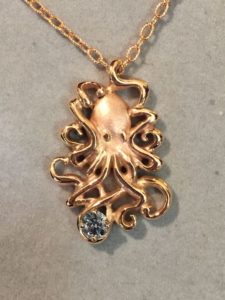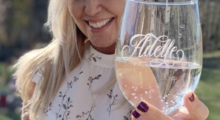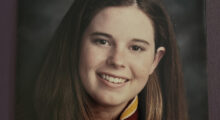Today, SevenPonds speaks with Claire McHan, operations manager and one-to-one support manager for Heart In Diamond, a company that specializes in making diamonds out of a loved one’s hair or ashes, converting them into beautiful pieces of jewelry that serve as memorial pieces for those who have died. From her Georgia home, McHan speaks with families about their wishes, suggesting the perfect diamond option based on color, size, and cut, and taking into account the loved one’s personality. Her goal is to personalize the grieving process, empowering families to choose how to remember their loved ones and their pets.

Credit: Claire McHan
Marissa Abruzzini: How does your company transform hair and ashes into different kinds of diamonds?
Claire McHan: First, the lab does a full chemical analysis and breakdown that is detailed on the client certificate. The carbon contained inside is then extracted and added to the diamond-growing foundation that we provide. From this, a crystalline matrix will grow, thus creating the diamond. The mixture is placed in an HPHT (high pressure, high temperature) machine where this unique and complex machinery will recreate the diamond-growing conditions that you see naturally growing deep in the Earth’s core. Temperatures get as high as 3,600 degrees, and the machines exert 60,000 atmospheres of pressure against the carbon to grow the diamond. After the growth phase, our specialists polish and cut your diamond in accordance with industry standards to accommodate your request.
Steps for Ordering a Diamond
- Contact Heart In Diamond directly, via email.
- Fill out the questionnaire they send you in the mail, and follow the instructions about net steps.
- Send the ashes or hair to Heart In Diamond either via your funeral director or according to the instructions provided.
- Sign a Chain of Custody document, giving Heart In Diamond permission to convert the ashes or hair into a diamond.
- The laboratory creates the diamond, after which it is carefully packed and sent to you.
Marissa: What are the benefits of having a lab-made diamond, as opposed to a natural diamond?
Claire: There are political and social issues associated with natural blood diamonds, (conflict diamonds) and also the negative impact that mining has on the environment. Lab-made diamonds don’t have these ecological or political problems. We don’t just make diamonds for those who have died, either. Our diamonds have a happy market, where we make wedding, engagement, and anniversary diamonds from a living person’s hair. Couples will both send me their hair, and we combine it to make engagement rings. In this situation, a couple is looking for something unique and ecologically-friendly.

Credit: Heart In Diamond. The company can make memorial jewelry out of a pet’s hair or ashes as well.
Marissa: How do you suggest showcasing these diamonds? What types of diamonds should a family consider for a memorial?
Claire: Families will often choose a color that evokes a memory. For example, a blue diamond will remind them of the color of that person’s eyes, or the red will symbolize love. I chose the orange-yellow because my dad passed away in Japan, so that color for me symbolized the land of the rising sun.
Settings are optional. We can use an existing item of jewelry, we can make a bespoke piece, or a client can have one sourced closer to their home. There are lots of choices and we will advise our clients regardless of whether they buy a setting from us or not. It has to be perfect, and we know that.
Rings and pendants are very popular, as well as a single earrings — ours all come with a secure safety back to them, for those worried about losing a small earring.
Marissa: How do you walk a client through an especially difficult loss, like the loss of a child?

Credit: Claire McHan
Claire: I am a mother, so what I do is extend the same care that I would want to receive for myself. Many mothers have babies that have not reached full-term, but they are still their babies regardless of which gestation period they reached. In these cases, I always refer to them as their children. I have to try and remain clear and concise on the calls, but after they’re over, I always crumble. I just think to myself how hard that must have been for a family to call me. They put so much trust in me, and they send me their child’s ashes…it’s just unbelievable. I am so humbled by their trust and will never get used to having to do this. I don’t ever want it to become routine.
Marissa: What do you want your clients to remember as they go through this experience for themselves?
Claire: I understand that this is a huge leap of faith for families to place their trust in us, and I am grateful. I want to reassure families that they will all be treated like family. It is as simple as that. One thing that our families will all tell you is that they never feel obligated to order. We give you all the help and guidance you need. When and if you are ready, we are here.
Be sure to catch up on part one of our interview with Claire McHan here.

 How Do You Convert Ashes Into Diamonds? An Interview with Claire McHan: Part Two
How Do You Convert Ashes Into Diamonds? An Interview with Claire McHan: Part Two


 Funeral Home Owner Chris Johnson Spending Halloween in Jail
Funeral Home Owner Chris Johnson Spending Halloween in Jail
 Our Monthly Tip: Toast a Loved One with a Personalized Glass
Our Monthly Tip: Toast a Loved One with a Personalized Glass
 My Cousin’s Death Taught Me the Meaning of Life
My Cousin’s Death Taught Me the Meaning of Life














